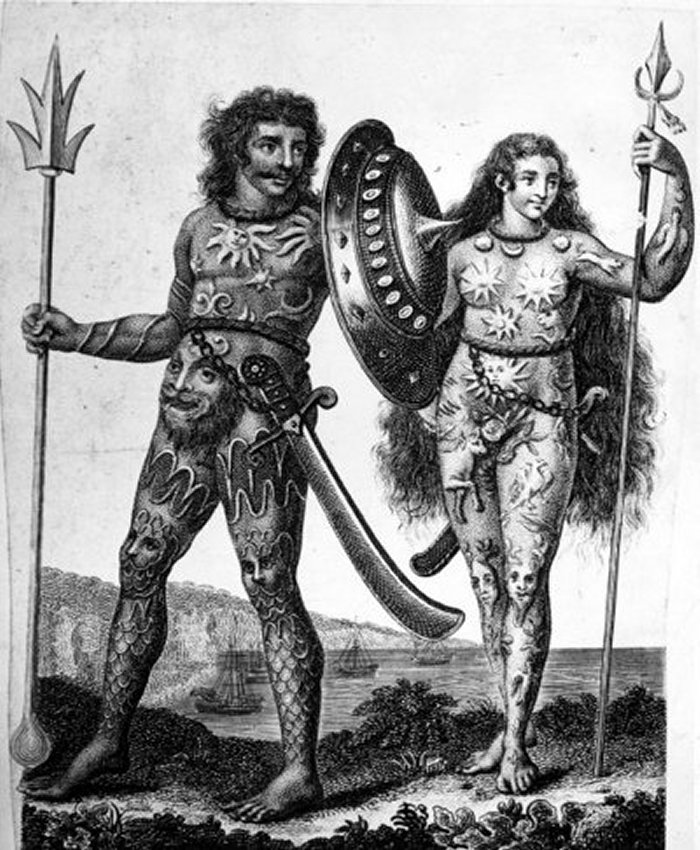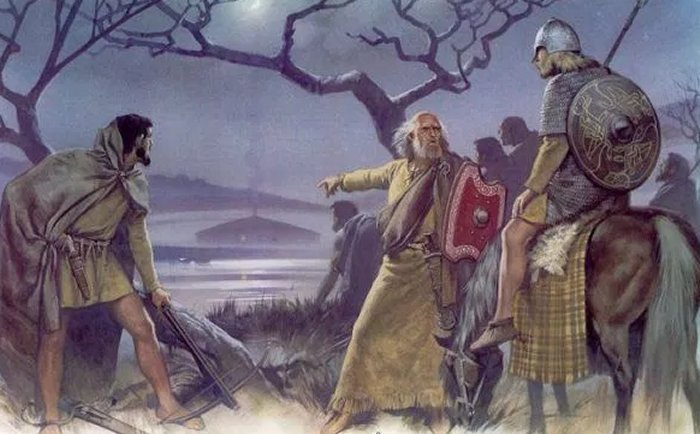MessageToEagle.com – Not much is known about the mysterious Picts and yet, they played a vital role in the history of Scotland. These brave and determined people repelled the conquests of both Romans and Angles and won one of the most important battles in Scottish history. The Picts used mysterious symbols that still haven’t been properly deciphered and their enigmatic language is now extinct. In this article we take in-depth look at the people of Northern Scotland and examine facts and history about the Picts.
The true identity of the Picts remains unknown
It is today generally accepted that the Picts were not a race of one people, but several tribes that united. They were driven by political motivations and a need to ally against common enemies. Were they Picts originally came from remains a mystery.
According to the Collins Encyclopedia of Scotland, “the Picts did not ‘arrive’ – in a sense they had always been there, for they were the descendants of the first people to inhabit what eventually became Scotland”. The Picts are often described as the descendents of the indigenous Iron Age people of northern Scotland and it is thought that they came originally from Scandinavia as a cohesive group. Since they left no written record of their history, what is known of them comes from later Roman and Scottish writers and from images the Picts themselves carved on stones.

The earliest surviving mention of the Picts dates from AD297 and it comes from the Roman writer Eumenius who referred to the tribes of Northern Britain as “Picti” (“the painted ones”), presumably because of their habit of painting their bodies with dye. The Picts are often said to have tattooed themselves, but evidence for this is limited. The Irish called the Picts the ‘Cruithne’.
The Picts’ mysterious language and symbols
The Picts’ language is a mystery and the meaning of the symbols stones they left remains an enigma. The language the Picts spoke has been lost, but more than 250 stones with Pictish symbols survived and these can give us a better understanding of the Picts. Some Pictish stones have written inscriptions. Pictish letters – called ‘ogam’ – had no curves, so were well suited for carving on stone.
Early symbol stones were rough, undressed boulders; later stones were carefully shaped and dressed.
The earliest stones show incised animals and geometric shapes unique to Pictish culture like the crescent and v-rod, the double disc and the serpent and z-rod.
Later stones were sculpted in relief, allowing the elaborate designs to stand out from the background. Designs include incised Christian crosses and biblical scenes.
The Dandaleith Stone is a rare symbol stone of the Picts. Scientists have long tried to decipher this remarkable and unique artifact and with a bit of luck scientists may unlock the secrets of the Dandaleith Stone in the near future.
Little is known about the Picts’ beliefs, society and daily life
Since the Picts did not leave any written records, it’s very difficult to get a clear insight into how they lived, their beliefs or society. The information historians possess originates from second-hand anecdotal evidence, lifted from the various historical writers who recorded their own, possibly biased, impressions of the Pictish people.
However, historians have been able to establish that Picts were farmers living in small communities. Cattle and horses were an obvious sign of wealth and prestige. The early Picts are associated with piracy and raiding along the coasts of Roman Britain. Even in the Late Middle Ages, the line between traders and pirates was unclear, so that Pictish pirates were probably merchants on other occasions.
Archaeologists have discovered evidence of watermills constructed by the Picts. The Brochs are also associated with the Picts. The word broch is derived from Lowland Scots ‘brough’, meaning (among other things) fort. The purpose of the Brochs is not entirely clear, but these roundhouse buildings have been found throughout Atlantic Scotland. Some historians and archaeologists think the Brochs were defensive military structures. Others have suggested the buildings were farmhouses.
The Picts lost the battle, but won the war against the Romans
What are some of the major and most important battle fought by the Picts?
Rome’s first incursions into Britain were in 55 and 54 BCE by Julius Caesar but began effectively in 43 BCE under Emperor Claudius.
In 79/80 CE, Julius Agricola, the Roman governor of Britain, invaded Scotland and pressed on to a line between the rivers Clyde and Forth by 82 CE.
Agricola faced the Picts with 11,000 soldiers of the 9th Legion and defeated them. The Picts attacked in the same form they would have grown accustomed to in tribal warfare, while the Romans held their position in strict formation and repulsed the charge, then counter-attacked. Although the Romans won the battle, allegedly killing 10,000 Pictish warriors, they could not capitalize on this victory. Unlike other nations which the Romans invaded, the northern reaches of Britain had no central cities which could be conquered. The Picts held their territory against the invading Romans in a number of engagements.
They were defeated in battle, they won the war. Scotland holds the distinction of never falling to the invading armies of Rome, even though the Romans attempted conquest numerous times.
The Picts were unconquerable because they presented the Romans with a new paradigm which Rome could not adapt to. The Roman legions had not yet encountered this kind of guerilla warfare.
In 122 CE the emperor Hadrian ordered the construction of his famous wall which ran for 73 miles (120 km), sometimes at a height of 15 feet, from coast to coast. In 142 CE, the Antonine Wall was constructed further north under the reign of Antoninus Pius. The Romans considered the Picts barbarians an to the Picts the Romans were an invading force that must be defeated,
The walls served as psychological as well as physical barriers. However, these walls did not discourage Pictish raids.
See also:
History Of Jarlshof – Thousands Of Years Of History With Traces Of Picts, Vikings And Scots
Runes: Facts And History About Odin’s Secret Language
Mystery Of The Beautiful Viking Uig Chessmen Found On The Isle Of Lewis, Scotland
Unraveling The Mystery Of The Grave Of Ancient Wizard Murdo Rivach In Scotland
When the Romans left Britain in 410 CE, the Picts still lived in the regions north of the wall as they always had. Whatever effect the Roman presence may have had on them is unknown, but the carvings the Picts left on their standing stones show no major differences in lifestyle from before the arrival of Rome to after the departure of the legions.
The Battle of Dun Nechtain – one of the most decisive battles in Scottish history
The Picts were courageous and determined. They repelled the conquests of both Romans and Angles. The Picts took part in one of the most decisive battles in Scottish history – the Battle of Dun Nechtain (Dunnichen).
The Battle of Dun Nechtain is one of the best recorded events in the history of Scotland.
On 20 May AD 685 a force of Northumbrians under King Ecgfrith faced King Bridei’s Picts at the Battle of Dunnichen. The Northumbrian Angles were annihilated.
The Venerable Bede wrote of King Ecgfrith:
… rashly leading his army to ravage the province of the Picts … the enemy made show as if they fled, and the king was drawn into the narrows of inaccessible mountains, and slain, with the greatest part of his forces Bede. (The Ecclesiastical History of the English People, c AD 731)
If the Picts had lost the Battle of Dun Nechtain, Scotland might never have existed. For the Angles of Northumbria it was simply a disaster – ending their domination of Scotland.
The Picts created a true north-south divide on the British Isles, only to disappear from history by the end of the first millennium – swallowed whole by the history of another group, the Gaels. Together they created the Kingdom of Alba.
Copyright © MessageToEagle.com All rights reserved. This material may not be published, broadcast, rewritten or redistributed in whole or part without the express written permission of MessageToEagle.com
Expand for references






